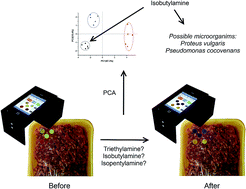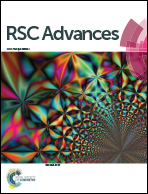Use of plastic-based analytical device, smartphone and chemometric tools to discriminate amines†
Abstract
Amine-based volatile compounds released by microorganisms offer an alternative diagnostic approach for the identification of foodborne pathogens. Our objective has been to solvent cast cellulose acetate membranes to immobilise dyes and to use the resultant membranes as a plastic device to discriminate between different types of amines (triethylamine, isobutylamine, isopentylamine). The plastic device consisted of an array of membranes with five pH indicators (namely alizarin, bromophenol blue, chlorophenol red, methyl red and thymol blue). To analyse the data using a portable instrument, we used an iPhone® to obtain images and to extract red, green and blue colours (RGB) using in-house software before and after contact with each individual amine. All the RGB values extracted for each analyte allowed us to generate a unique colour pattern, which was used as input for non-supervised pattern recognition methods. Based on this analysis, it was possible to clearly discriminate between the amines studied without any misclassification, demonstrating that the device is well-suited for large-scale applications such as non-destructive methods to discriminate amines and, in future, for smart packaging applications in order to give early warning of rotting food that may lead to food poisoning. Additionally, a semi-quantitative analysis was performed and we have demonstrated that it is possible to quantify concentrations of amines down to 1 ppm.


 Please wait while we load your content...
Please wait while we load your content...